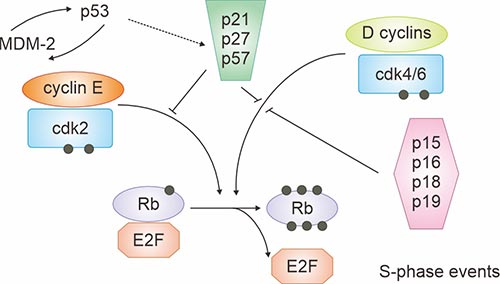宫颈癌
宫颈癌是全球女性第二常见的癌症,每年估计发生约500,000例病例和超过270,000例死亡 [1]。宫颈癌是女性宫颈细胞发生变化导致的,宫颈连接子宫与阴道。
目前,越来越多的科学研究表明的科学研究表明宫颈癌是一种性传播疾病,由某些高风险的致癌型人乳头状瘤病毒(HPV)感染引起,该病毒是约100种相关病毒的一组。其中,HPV 16是最重要的高风险HPV型别,HPV 18是第二常见的。高风险HPV与其他HPV型别的区别在于其两个蛋白质E6和E7的致癌特性,这些蛋白质可能干扰细胞调控和分化。
在癌症中,HPV E6蛋白可以对细胞肿瘤抑制基因p53产生作用。 p53基因的改变通常包括缺失、插入和点突变。p53基因负调控细胞周期,肿瘤形成通常需要“功能丧失”突变 [2]。癌症中的E7蛋白似乎是由于其对Rb基因产物及其相关蛋白p107和p130的作用 [3] [4]。在细胞周期的正常细胞增殖过程中,受到cyclins和cyclin dependent kinases (cdk)的影响,它们相互作用并磷酸化底物,如Rb蛋白(图1所示)。

图1. G1进程的调节因子
*此图表来自Cancer [4] 的出版物
宫颈癌的全面基因组分析揭示了一些新的基因突变和扩增。这些突变的基因包括SHKBP1、CASP8、HLA-A、TGFBR2和ERBB3(约占肿瘤的6%等)。在本文中,我们根据NCG网站提供的信息列出了宫颈癌中涉及的部分蛋白质。NCG是一个用于分析癌症基因的重复性、同源性和网络特性的网络资源。
在此,我们展示了参与宫颈癌发生机制的几个关键靶点,包括:
● FBXW7(F-box和WD重复结构域蛋白7)是一个编码Skp1-Cul1-F-box蛋白(SCF)泛素连接酶亚基的基因。SCF FBXW7靶向一组众所周知的癌基因蛋白,包括c-Myc、cyclin E、Notch、c-Jun和Mcl-1,进行泛素化和降解 [5] [6]。据报道,FBXW7参与调控许多细胞过程,包括细胞增殖、细胞周期、凋亡和分化 [7] [8]。在宫颈鳞状细胞癌中,FBXW7经常发生突变 [9]。
● HLA-B(主要组织相容性复合体I类B)是一组称为人类白细胞抗原(HLA)复合体的基因的一部分。HLA复合体帮助免疫系统区分自身蛋白和病毒、细菌等外来入侵者制造的蛋白。人类白细胞抗原(HLA)基因高度多态,并且已被证明是HPV感染持续和疾病进展的重要风险因素 [10]。
● NFE2L2(核因子、类似于2的红细胞)是一个对氧化还原敏感的转录因子,在食管、甲状腺和其他组织中广泛表达 [11]。NFE2L2介导的氧化应激是宫颈癌的一个显著特征,促进宫颈癌细胞的增殖,抑制细胞凋亡,并增强细胞的迁移和侵袭能力,同时增加肿瘤的化疗抗药性 [12]。
● PIK3CA(磷酸肌醇-4,5-二磷酸3-激酶)是I类PI 3-激酶催化亚单位。TCGA宫颈鳞状细胞癌研究中,PIK3CA突变的患病率为27.1%。同时,PIK3CA突变的宫颈癌显示出比非突变癌症更高的肿瘤突变负荷(TMB)[13]。新出现的证据表明,在携带放大的PIK3CA基因的宫颈癌细胞系中,PIK3CA基因产物(p110α)的表达增加,随后与高激酶活性相关联。
参考文献:
[1] Mammas I, Sourvinos G, Giannoudis A, Spandidos D. Human papillomavirus (HPV) and host cellular interactions [J]. Pathol Oncol Res. 2008, 14:345-54.
[2] Okechukwu A. Ibeanu. Molecular pathogenesis of cervical cancer [J]. Cancer Biology & Therapy. 2011, 11:3, 295-306.
[2] Levine, A.J. et al. The p53 tumor suppressor gene [J]. Nature. 1991, 351,453–456.
[3] Vogelstein, B. and Kinzler, K.W. The multistep nature of cancer [J]. Trends Genet. 1993, 9, 138–1341.
[4] Pamela T. Soliman, Brian M. Slomovitz, Judith K. Wolf. Mechanisms of cervical cancer [J]. Cancer. 2004, 2(1): 1740-6765.
[5] Cheng Y, Li G. Role of the ubiquitin ligase Fbw7 in cancer progression [J]. Cancer Metastasis Rev. 2012, 31:75–87.
[6] Li M, Ouyang L, Zheng Z, et al. E3 ubiquitin ligase FBW7alpha inhibits cholangiocarcinoma cell proliferation by downregulating c-Myc and cyclin E [J]. Oncol Rep. 2017, 37:1627–1636.
[7] Welcker M, Clurman BE. FBW7 ubiquitin ligase: a tumour suppressor at the crossroads of cell division, growth and differentiation [J]. Nat Rev Cancer. 2008, 8:83–93.
[8] Jiang Y, Qi X, Liu X, et al. Fbxw7 haploinsufficiency loses its protection against DNA damage and accelerates MNU-induced gastric carcinogenesis [J]. Oncotarget. 2017, 8:33444–33456.
[9] Faying Liu, Yang Zou, Feng Wang, et al. FBXW7 Mutations Promote Cell Proliferation, Migration, and Invasion in Cervical Cancer [J]. Genet Test Mol Biomarkers. 2019, 23(6):409-417.
[10] Anna Paaso, Anna Jaakola, Stina Syrjänen et al. From HPV Infection to Lesion Progression: The Role of HLA Alleles and Host Immunity [J]. Acta Cytol. 2019, 63(2):148-158.
[11] M. Hämäläinen, H.-R. Teppo, S. Skarp et al., NRF1 and NRF2 mRNA and protein expression decrease early during melanoma carcinogenesis: an insight into survival and microRNAs [J]. Oxidative Medicine and Cellular Longevity. 2019.
[12] Qiang Ju , Xinmei Li, Heng Zhang et al. NFE2L2 Is a Potential Prognostic Biomarker and Is Correlated with Immune Infiltration in Brain Lower Grade Glioma: A Pan-Cancer Analysis [J]. Role of Redox Homeostasis in Cancer Biology and Anticancer Therapy. 2020.
[13] Yen Ying Ma, Sung Jen Wei, Yu Chen Lin et al. PIK3CA as an oncogene in cervical cancer [J]. Oncogene. 2000, 19(23), 2739-2744.






